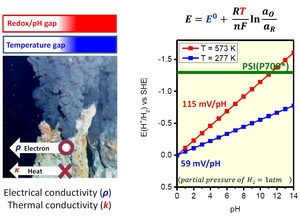ELSIセミナー
SEMINAR
October 12, 2016
Electron flow for carbon fixation in deep-sea hydrothermal environments
- スピーカー
- Ryuhei Nakamura
(Biofunctional Catalyst Research Team, RIKEN Center for Sustainable Resource Science) - 日付
- October 12, 2016
- 時間
- 16:00
- 場所
ELSI-1 Building - 102 ELSI Hall
How has nature handled electron flow for carbon fixation? We know the mechanism of carbon fixation taking place inside chloroplast. At least, we know the framework of its action and function. Parallelly important, yet relatively unknown processes are carbon fixation taking place in deep-sea hydrothermal environments, which contain low levels or no solar radiation. In such environments, nature has to develop the systems to harvest geochemical and geothermal energy to generate high-energy electrons needed for activating CO2. Yet, how nature utilizes temperature and chemical gradient fostered by geological settings remains largely unknown.
In this talk, based on our findings of electrical current generation across a black smoker hydrothermal vent [1,2], together with thermoelectrical conversion by deep-sea minerals [3], I provide the new energetic underpinning of carbon fixation: de-coupled electron and heat transfer at deep-sea hydrothermal vents (Fig. 1; please refer to the post on the website) [4,5]. As catalysis at the deep-sea vent may tightly link with the origin and evolution of life [6], I provide the perspective to predict the first engine that drives the life emergence and fosters life complexity [7,8].

In this talk, based on our findings of electrical current generation across a black smoker hydrothermal vent [1,2], together with thermoelectrical conversion by deep-sea minerals [3], I provide the new energetic underpinning of carbon fixation: de-coupled electron and heat transfer at deep-sea hydrothermal vents (Fig. 1; please refer to the post on the website) [4,5]. As catalysis at the deep-sea vent may tightly link with the origin and evolution of life [6], I provide the perspective to predict the first engine that drives the life emergence and fosters life complexity [7,8].

Fig.1. The pH and temperature gap between hydrothermal fluid and sea water can generate the reduction power as high as that of photosynthetic CO2 fixation center (PSI).
(1) R. Nakamura, et al. Angew. Chem. Int. Ed., 49, 7692 (2010). (2) M. Yamamoto, et al. Angew. Chem. Int. Ed., 52, 10758 (2013). (3) R. Ang, et al. Angew. Chem. Int. Ed., 54, 12909 (2015). (4) A. Yamaguchi, et al. Electrochim. Acta, 141, 311 (2014). (5) A. Yamaguchi, et al. Springer, Chapter 4.3.2. (2016). (6) M.J. Russell, et al. Astrobiology, 14, 308 (2014). (7) T. Ishii, et al. Front. Microbiol., 6:994 (2015). (8) A. Yamaguchi, et al. Nat. Commun. 4256 (2014).












